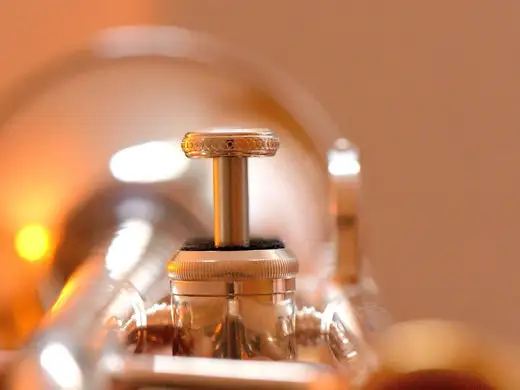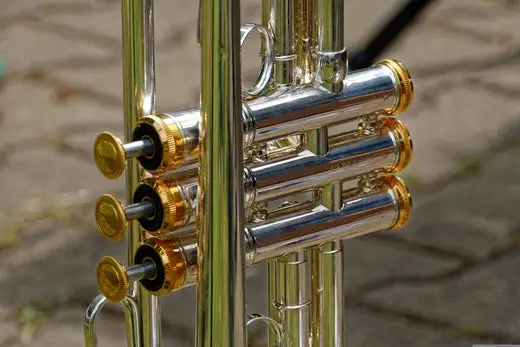Trumpet Mutes
Almost every band director has the sensation of browsing through a music catalog and entering in a kind of trance, faced with endless choices of equipment of every description. With the various shapes, materials, and brands available, trumpet mutes can be particularly trance-inducing, particularly for someone who is not a brass player.
This article should help reduce some of the confusion surrounding the many materials and styles available, as well as providing some concrete suggestions you can give your students as they are learning to play with mutes.
First of all, a mute is an object inserted in the bell of a trumpet which slightly muffles the instrument’s vibration. Although mutes will make the trumpet quieter, their primary purpose is to alter the tone color to achieve a particular effect.
The typical mute is held in the bell by three strips of cork along the side of the mute, so there is an air pocket between the mute and the bell. This type of mute has a hole in the top, through which a portion of the sound waves from the trumpet pass into the mute and are absorbed or reflected back by the mute cavity.
The vibrating air pocket between the mute and the bell then blends the unmuted trumpet sound and the muted vibrations in complex ways. This characteristic blend of sound is transmitted out the trumpet bell, and gives each mute its characteristic timbre.
Mutes may be made from cardboard, aluminum, brass, copper, synthetics or polymers, or combinations of materials. Mutes may also consist of cloth bags or other soft material that yields the desired sound quality.
Occasionally a composer will ask for the player to mute the sound simply by playing into the music stand, by leaning in toward the stand. The bell should be about six inches from the stand (if the student leans in too far the pitch will start to go flat). The resulting sound will be more diffuse and less directional. Directors can use this technique to make a single trumpeter or a section of trumpeters sound distant. This effect can be used if the music states “in hat” and the student does not own a hat mute.
Playing with a Mute
Since mutes are placed in the path of the trumpet’s air column, they have the possibility of slightly altering the trumpet’s pitch. In general, mutes that go into the bell may make the pitch sharp, since the air column is being effectively shortened. Mutes placed in front of the bell, such as a cloth bag or plunger, are effectively lengthening the air column, and may flatten the pitch. One of the characteristics of a good mute is that it affects the trumpet’s intonation only minimally.
Students should always practice their band, orchestra, or solo music as it is marked, including mute changes, since the mute will slightly affect not only intonation, but also responsiveness and volume. They will also need to practice coordinating the insertion and removal of the mute when the changes are fast.
A tuner will help students to find the correct adjustment for their main tuning slide when the mute is inserted and removed (typically about a quarter of an inch adjustment or less). Students can place a pencil mark on the tuning slide to serve as a quick reference during practices and performances.
In addition to affecting the intonation, most mutes will tend to dull the articulation slightly, so the students will typically need to use more air and articulate more heavily to compensate. The articulation of the open trumpet will feel much easier and faster by comparison.
Mute Choices and Markings
Although performers will often be the ones making the choices about mutes in jazz and other improvised styles, printed music will specify when to place and remove mutes. If the music doesn’t specify the type of mute, then a straight mute is assumed, although the director or player may experiment with other mutes until the desired sound is achieved. If the composer wants something other than a straight mute, the direction will be printed above or below the staff.
Students will typically see the direction “mute” to apply the mute, and “open” or “without mute” for the next passage played without the mute. The Italian con sordino (“with mute”) or senza sordino (“without mute”) may also be used.
Mutes in the Band Classroom
Across the various types and brands of mutes, the qualities of a good mute remain the same: (1) consistency in all pitch and dynamic ranges, (2) ease of response, (3) secure, stable fit in the trumpet bell, (4) minimal change in intonation, (5) desired sound quality, and (6) ability to easily produce the desired volume of the passage being played.
Because mutes vary somewhat in terms of material and construction, directors should optimally decide on one particular mute brand and style for your trumpet section to use. If possible, try to purchase a matched set of mutes for the band to own, which the students can check out when needed. Alternatively, you can have your trumpeters buy the type and brand that you specify at the beginning of the school year.
When choosing a brand for your trumpet section, make sure you like the sound of the mute you’re about to order. If you are not familiar with the sounds of various styles available, ask a professional brass player or teacher to demonstrate some different mutes for you. Explain to them what pieces you are preparing, and be specific in the type of sound you are looking for in a mute. They should be able to point you in the right direction.
Mutes have no place in the beginning band year. It is not until the seventh-grade year when the band begins preparing contest literature that you will need to start thinking about mutes. At the middle school level, a set of straight mutes will be adequate if you don’t have a jazz program. A jazz program at any level will need a complete set of straight, cup, harmon, and plunger mutes (see below for descriptions). At the high school level, all bands should have all four types available, since even the concert band will be playing a broader range of literature that may call for these effects at some point.
Jazz and classical pieces may also use specialized mutes to create very specific colors. You may occasionally need to purchase one of the other mutes listed below, or a specialty mute not described here. For example, very hushed band or orchestral passages may necessitate a specialty mute such as the Denis Wick wooden mute.
It may be worthwhile to call ahead and have your local music store order your mute selections so the mutes will be there for your students to pick up. If the students do their own ordering, they may or may not get the mute in time for the rehearsal it is required for.
Placing Mutes During Performance
Many a quiet moment during a concert has been jarred by the inadvertent fall of a mute. To avoid an unplanned moment in the spotlight, students should use a mute rack if possible. During quick mute changes, the student can use the pit of their arm, between their legs, or under their knee.
If the student isn’t using a mute rack, a good alternative is placing the mutes on a black- or charcoal-colored towel. If they are standing to play, the towel will be folded several times and placed on a music stand at half height, with the desk flat. If performing seated, the student should place the towel on the floor instead.
To place a mute, the student will need to blow warm air into the inside of the bell to create condensation and enable the cork to better stay in place. Have the student put the mute in until it’s tight, then give one more push to compress the corks. Then have them twist the mute a few degrees to lock it into place. In the case of a practice mute and harmon mute, the mute should make an airtight seal with the bell; other mutes will have an air passageway between the mute and the bell.
Certain brands of straight mutes and cup mutes have felt lining around the outer diameter of the top of the mute to minimize the sound of inserting the mute, and also to protect the finish of the trumpet from small scratches due to repeated use.
If the mute keeps slipping out of the bell, it may be either because of a lack of moisture, or because the corks are so well-worn they have become too smooth to provide traction. The mute may also slip if the corks have become too compressed to keep the mute snug. A few gentle rubs from the sandpaper should be enough to roughen the surface of cork that has become too smooth; if the corks are too compressed, they will need to be replaced.
If the corks are simply dirty or oily you can clean them with a bit of rubbing alcohol (do not use water, which evaporates more slowly and may cause the corks to swell).
Care of Mutes
While it is normal for mutes to accumulate some amount of wear and tear, including dents, students need to protect the mutes as much as possible, since major dents will change the way the mute fits and vibrates, and a leak can result in poor intonation and a change in response. The best way to care for mutes is to carry them in a mute tote bag, which will allow the student to transport several mutes safely to and from school. These bags are relatively inexpensive and can be used for other accessories as well.
While some players wrap each mute individually in a sock or cloth, it is generally fine for mutes to move around and rub against one another in the tote bag. Some of the more expensive mutes may come in their own cloth mute bag; this will protect the finish but doesn’t provide much cushioning, so a quality tote is still a good idea.
If a mute develops a leak along a seam, you can try to find the leak by blowing into the mute and feeling where the air is coming out. You may be able to seal the hole with epoxy or another sealant, but if this isn’t possible the mute will need to be replaced.
Caring for the Corks
At one time, mute manufacturers used what is called natural cork. Like the cork of a wine bottle, it was relatively rigid and difficult to compress. During that time, players usually needed to shave their mute corks to get a proper fit.
Since most mutes now use compressed cork granules or neoprene-enhanced composite cork, both of which adjust to the contour of the bell, it is no longer necessary to shave the corks unless the mute needs to be inserted farther into the bell (either for sound color or because it plays flat).
When a student is beginning to play with a brand new mute, have them leave the mute in their trumpet overnight for a few nights so that the cork can mold itself to the bell contour.
After this initial break-in period, have the student spot check the intonation of the mute through different registers and dynamics of the trumpet, noting any pitch tendencies which they will need to compensate for. While a good, well-fitted mute will affect the pitch only minimally, students can expect some day-to-day variability, requiring them to compensate slightly at the main tuning slide, about a ¼ inch adjustment or less.
If a mute plays flat and you must shave the corks, you will need either a fingernail file or a piece of very fine sandpaper. Be careful; a little bit of sanding goes a long way. If you overshoot, the pitch, sound color and ease of playing may be adversely affected.
If the corks become damaged, you can buy replacement corks from your local music store or order them online. Attach the replacement corks using an impact adhesive (a strong glue which begins to bond the materials upon contact).
Mute Materials and Sound
A mute may be made of primarily one material or may use mixed materials in order to blend the characteristics of each. Aluminum has the brightest sound of all the metals. Brass has a warmer, more mellow sound than aluminum, while copper has the warmest and richest sound.
The familiar red and white mutes known to band classrooms across the country are made from lexan polycarbonate. They are otherwise known as “stonelined” mutes and are virtually impossible to dent. Their sound is somewhat duller than that of the more resonant metal mutes.
Jazz players often use the stonelined variety of straight mute because the sound color changes across the dynamic range, providing for greater versatility in the sound. The metal straight mutes have a more defined sound that tends to remain the same across the dynamic ranges.
If a given passage calls for more than one player to be muted, the trumpeters should use the same brand and type of mute for a unified section sound and blend. This will also help ensure consistent intonation between players, since the mutes will have the same pitch tendencies.
If a more muted sound is desired, mute silencers may be a good option. Made by Gerald Endsley, these cylindrical foam discs slide down the narrow top of the mute and rest around the bottom diameter, about an inch from the end of the mute. (For the cup mute, the foam can be pushed into the gap between the cup and the inner cone.) These rings can make it easier to play soft musical passages (the player can get away with using more air), or they can be used to create a practice mute effect.
Types of Trumpet Mutes
The straight mute, the most commonly played mute, may be either cone- or pear-shaped, and is the first mute a student should buy. The straight mute gives the trumpet a sizzling, distant sound, for example, the opening of Respighi’s “Pines of Rome” or Shostakovich’s Symphony No. 1 opening trumpet solo. This mute dampens the trumpet sound less than most of the other mutes. A straight mute may make the trumpet play sharp, which can be compensated by moving the tuning slide out a bit.
The aluminum straight mute has the most traditional tone color for a straight mute. While the red-and-white polycarbonate variety is common in high school bands because of its extreme durability and low cost, the aluminum straight mute is superior in sound for symphonic playing. Other varieties of the straight mute are used for their specific tone color and can be purchased later as the occasion requires.
If the sound is not as muted as you want, it is possible to put cotton into the body of a straight mute or cup mute to help quiet the sound, making it gentler and more distant. The student should start off with three cotton balls and not use more than ten or so, pushing the cotton through the opening with a pen to get it past the narrow part of the shaft. To remove the cotton, the student will need to turn the mute upside down and use an unfolded paperclip or finger to reach into the shaft and remove the cotton.
A cup mute will need to be added into the trumpeter’s arsenal during high school when they are starting to play a wider variety of music. Quieter than a straight mute, a cup mute will give the trumpet a soft, warm, covered sound.
A relatively recent development in cup mutes is a design that allows for the moving of the cup on the mute stem, called an “adjustable cup.” This allows for greater color changes compared to a fixed cup. The intonation of adjustable-cup mutes is better than that of the fixed cup, offering another advantage to this design. Although a synthetic fixed cup is the most common among high school students, adjustable cup mutes with an aluminum cone are quickly becoming the standard cup mute for students and professionals alike.
If you have a fixed cup mute, you may need to shave the corks in order to get the cup close enough to the bell for that characteristic cupped sound. The distance between the lip of the bell and the lip of the cup should be between ½ and ¾ inch. For the adjustable cup, you can achieve the correct distance by moving the cup itself. A great audio example of the cupped sound would be Dizzy Gillespie’s “Night in Tunisia.”
The quietest of all the trumpet mutes, practice mutes can cut the sound by more than 70% and are a good solution for a kid who wants to practice late at night without disturbing family or roommates. Although it’s not a good idea to practice this way all the time, it can definitely help make practice time more flexible. Since it is really a type of straight mute, the practice mute may cause the trumpet to play sharp, so students will need to compensate with the tuning slide.
The lower range is more difficult than the higher range when using a practice mute; its resistance makes it difficult to move the large volume of air needed in the low range. The articulation with a practice mute will be more laborious than in usual playing, so a student who has been practicing with a practice mute will feel much freer in their articulation upon returning to normal playing.
The key difference between a standard mute and a practice mute is a practice mute actually seals off the passageway between the mute and the bell with a solid ring of cork, so that all of the sound must pass through the mute itself. The mute body contains small vent holes to allow the air to escape through.
The Yamaha Silent Brass is a distinctive practice mute, allowing the student to plug earphones into the sound module and hear their sound as though they are playing the open trumpet. They can even choose from among several acoustics, such as a concert stage or cathedral. A more expensive model actually includes a pitch shift feature to correct the intonation without using the tuning slide and offers metronome, drum patterns, and various other features.
A practice mute can help a student develop their loud playing since the resistance of the mute causes the back of the throat to open reflexively, allowing a greater volume of air through. This physical skill can then be transferred to the open trumpet.
Plunger mutes are used mainly by jazz musicians and are usually made of rubber or of aluminum with a flock-sprayed interior. A metal plunger mute will create a “wa-wa” that is more metallic and buzzy, while a rubber plunger has a warmer sound. Plunger mutes are very popular in Dixieland music.
Plunger mutes use a different notation to conveniently indicate movements of the plunger from note to note. The “+” sign means the plunger is over the bell, while “o” means to open the plunger – sometimes with both instructions appearing on the same note.
The following is an example of this notation as it appears in Gershwin’s Rhapsody in Blue, in this instance for harmon mute
In jazz band, it is also not uncommon for a composer to request a “wa-wa” effect using only the hand. The student will place the lower left edge of the bell into the crease of their hand where the fingers meet the palm, with the fingers as close together as possible (but not cupped or scrunched). Opening and closing the hand in front of the bell will create a “wa-wa” effect that is more subtle than that created by a plunger mute.
Plunger mutes can either be purchased in a music store (these are shaped more like a drinking cup) or at your local hardware store (ask for a sink plunger). Of the several available sizes of rubber plungers, choose the size closest to the diameter of the trumpet bell or a little smaller.
When using a plunger mute, the right hand will use the pinky hook to support the trumpet, while the left hand holds the plunger in the air in front of the bell. The student should use their wrist to move the plunger into the path of the air, opening the wrist as far as necessary to achieve a difference in sound. The plunger should not close fully over the mouth of the trumpet – there should be a slight gap. (If the plunger is closed against the trumpet bell it will flatten the pitch too much, distracting listeners from the desired change in tone color.)
Mute tip: When using a household plunger, most professionals simply cup their hand over the plunger to hold it. However, some players prefer to cut a hole through the plunger in the center, where the wooden handle ordinarily inserts. The hole should be finger-width (i.e., smaller than the opening for the stick). Once this is done, the middle finger goes into the hole for added security, while the hand cups over the rest of the mute. This technique provides a more secure grip on the plunger mute, allowing for better control and manipulation during performance.
Harmon, or “wa-wa” mutes, are used primarily by jazz musicians and can be made of various materials. The reason that everyone calls these mutes harmon mutes is because the Harmon Mute Company was the first company to produce this style of mute. Today the term refers to the style rather than the specific brand, although the Harmon Mute Company is still alive and well.
A harmon mute greatly reduces the volume and produces a distant, buzzy sound, requiring a lot more air to play. A copper harmon mute creates a richer muted color and is preferred by most jazz musicians. Harmon mutes are also found in contemporary concert band and classical music, and tend to be of the aluminum variety.
A harmon mute has two separate parts: the body (a funnel-shaped portion which inserts into the bell) and the stem (a removable tube). Trumpeters can play with only the mute body in the trumpet (a more mellow sound), or with the stem inserted (a very buzzy sound). With the stem in, the “wa-wa” effect can be created by opening and closing the hand over the end of the stem. In addition, a variety of different tone colors are possible depending on the degree to which the stem is pulled in or out.
When “harmon mute” appears written in a jazz piece, it is assumed that the player should use the mute without the stem, whereas “harmon mute” in a classical piece assumes that the stem should be in. The famous trumpet solo in Gershwin’s “Rhapsody in Blue” is a good example of the harmon mute sound with the stem in, while Miles Davis’ “My Funny Valentine” is played with the stem out. A favorite mute among jazz musicians is the all-copper “bubble mute,” which creates a loud, very distinctive buzz.
Like a practice mute, the cork of the harmon mute creates a seal between the trumpet and the mute, so that all the sound produced by the trumpet is forced through the mute. This mute also has the potential to play sharp, so the student will need to pull the tuning slide out.
Mute tip: The stem of a harmon mute may tend to become loose and rattle. If this happens, grease the tube with some heavy grease or petroleum jelly to tighten the fit.
Cloth Bag Mutes, Pixie Mute, and Bucket Mute
Cloth bag mutes give the trumpet a soft, velvety tone. Bag mutes are used mainly by jazz musicians and cause the trumpet to play flat. Although the purple Crown RoyalTM bag is most common among professionals, a polishing cloth or a soft cotton rag can also be used.
Students can either drape the bag over the top of the bell so that it hangs about halfway down into the air stream, or actually place the entire trumpet bell inside the bag. In the latter case, allow some of the bag to hang loose beyond the bell, rather than pushing the bell all the way to the back of the bag. When searching for the right sound color, remember that a heavier fabric will sound more distant (as well as causing more flattening of the pitch).
Various pieces, including Gershwin’s “An American in Paris,” may specify using a “felt crown mute.” In this case, the player may use the usual cloth bag or may place a velvet hat or baseball cap over the bell.
The pixie mute is the shortest of all the standard trumpet mutes inserted into the bell, and is used in combination with jazz solo plunger work to imitate vocal effects such as laughing or talking. The sound is brighter and more nasal than simply using the plunger alone and may cause the trumpet play sharp.
Heard predominantly in the jazz realm, a bucket mute creates the illusion that the trumpeter is playing into a bucket, except with a slightly warmer, more velvety sound. The largest of the trumpet mutes, bucket mutes are filled with a soft, sound-absorbent material. The bucket mute sound has about the same volume as an adjustable cup pushed almost all the way in, but with a richer, darker sound, similar to a flugelhorn.
One type of bucket mute inserts into the trumpet bell like a straight mute but is attached to a large cylinder filled with sound-absorbent material. This mute style allows for slightly faster mute changes and is more durable. A second kind of bucket mute clips onto the trumpet bell; the fabric-filled bucket is open on the side facing the bell. While the lining can be glued back if it becomes loose over time, broken or bent clips can be another problem with this style, making the first type a better choice for most players.
Derby Hat Mute
The derby hat mute got its name from the hat worn by men in the 20s and 30s and lends a covered, velvety sound to the trumpet. The end of the trumpet bell actually inserts into the bowl of the hat, creating an interesting visual effect as well as the change in sound color. A derby hat can be used essentially like a plunger for a “do-wah” effect, made popular by the big bands of the 1930s and 40s. Derby hats can be made of suede, metal, or plastic.
A Mute for Every Occasion
Trumpet mutes are inherently an aspect of playing with an element of subjectivity and personal preference. It takes some time to develop a sensitivity for the sound colors traditionally used in the various styles, from jazz to classical to Dixieland. You will start to get a feel for each of these styles only by spending some time with recordings, attending shows, and becoming familiar with trumpeters’ stylistic decisions regarding mutes and tone color.
However, as you browse through that catalog with endless pages of mutes to choose from, you will now have enough information to make an educated decision that will get you started, and to get your valuable trumpeters using their mutes confidently and correctly.
A Note on Specialty Mutes
Specialty mutes are often special straight mutes that are chosen to apply to a specific tone color or characteristic to a given musical passage. These mutes will often take away the metallic resonance and add a warmer quality to the sound. These mutes can be made from wood, plastic, or other composites to round out the sound or to simply soften the sound enough the player can use more air in a passage without being noticeably louder.
A Note on Specialty Sizes
The mutes used for Bb trumpet, C trumpet, Eb/D and E trumpet, and cornet are usually interchangeable, while the flugelhorn, piccolo trumpets in A/Bb/C and F/G require specialized smaller mutes. Some manufacturers are now making special cup mutes for D/Eb trumpets, whose bells are generally smaller and require a slightly smaller cup for a proper fit. As far as flugelhorns are concerned, their mutes are oversized to fit their larger bells. Mutes made for this instrument are straight mute, practice mute, harmon mute, Yamaha Silent Brass, and cup mute.
The only mutes made for piccolo trumpet are straight mute, harmon mute, cup mute, and practice mutes. The Yamaha Silent Brass is made for piccolo trumpets as well. A great musical example of piccolo trumpet playing with a straight mute is Mussorgsky’s “Pictures at an Exhibition,” where it gives a shimmering sound in the “Samuel Goldenberg und Schmuyle” movement.







